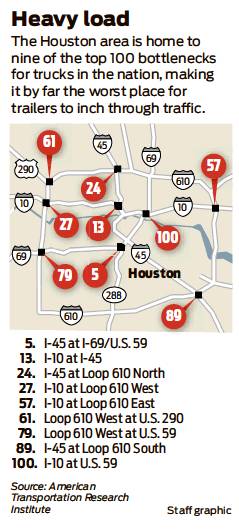Houston area’s truck bottlenecks are sore spot for big rigs, others
By Dug Begley STAFF WRITER
When it comes to the nation’s biggest truck bottlenecks, Houston freeways are all choked up.
Nine of the top 100 truck bottlenecks in the nation are in Houston, according to a report released Tuesday by American Transportation Research Institute. If the area around and along Loop 610 were a state, it would have the most locations on the top 100 list, topping the seven in California.
The 2019 ranking also saw a Houston bottleneck burst into the top 5. The Interstate 45 intersection with Interstate 69 south of downtown jumped 13 places from number 18 to fifth-worst in the country, likely as aresult of the construction at the location.
State transportation and trucking industry officials said the ranking reflects both lengthy work zones in Texas and the Houston area and the huge demand for the movement of goods across the state.
“Texas has a growing population and a booming economy,” Texas Trucking Association CEO John Esparza said. “But traffic congestion could bring all of that to a standstill.”
Three of the intersections listed are under construction, with at least three others set for construction.
“The good news is, we are addressing these bottlenecks,” said Marc Williams, deputy executive director of the Texas Department of Transportation. “Unfortunately, there is not a magic pill to cure these things overnight.”
Since 2002, the ranking is compiled annually by tracking average truck speeds in 300 locations using GPS devices on nearly 1 million heavy-duty trucks. From the data, researchers can determine exactly where freight is getting gridlocked, information that informs how carriers change their routes and states plan for congestion relief.
The findings are based on 2017 traffic data, something that likely worsened Houston’s ranking, said ATRI president Rebecca Brewster, who oversees the report.
“This would have the increased truck trips you have post-Harvey,” she said, referring to the torrential August rains that deluged the region. In the wake of the flooding, there was ahuge uptick in truck trips as materials to rebuilding homes poured into the region.
Even in a normal year, however, Houston capturing so many spots on the list was not shocking, Brewster said. It is home to a major port, a growing population, and major freeways.
“You are really a victim of your own success in this instance,” Brewster said.
Drivers, both of big trucks and the cars around them, also note the worse places currently have orange cones.
“Everywhere there is construction, things just stop,” said Paul Miller, 65, who added he is three months from retirement and free of his workday trips between downtown Houston and Pearland.
Work in the past two years has affected traffic flows along Loop 610 at U.S. 290, I-45 and I-69 which shot up the list and I-45 and Loop 610 south of downtown.
That construction, however, also is the salvation of the slowdown, notably in places where freeways have “a lack of capacity to handle the demands that are out there,” Williams said.
More work is on the way, he said. The massive rebuild of the I-45 connections with I-69 and Interstate 10 will address two of them, Williams said. As that project — estimated at $7 billion to rebuild the freeway north of downtown to the Sam Houston Tollway — moves forward, it also will remake the I-45 and Loop 610 interchange north of downtown.
Brewster noted other hotspots for truck congestion have eased as their work wrapped up, notably the Circle Interchange in Chicago where three interstates converge.
It led the list for three straight years, but dropped to seventh in 2019, even though construction has not finished.
That same trajectory of worsening then improvement could await Houston area interchanges, Brewster said. Though with so much activity, it is unlikely the region’s worst locations will fall from the list entirely.
“You’re always going to have that volume and congestion because you have a lot going on,” she said. dug.begley@chron.com twitter.com/DugBegley

